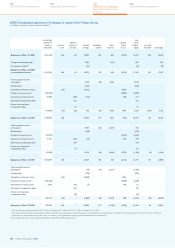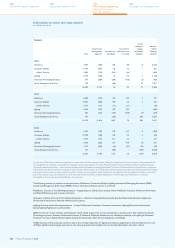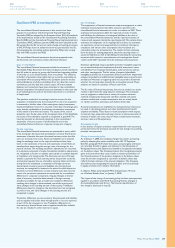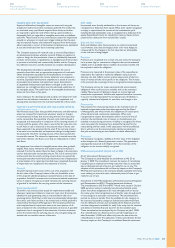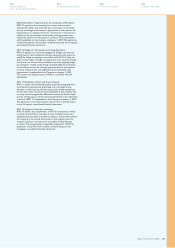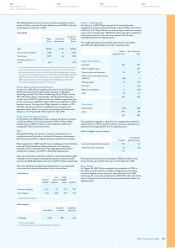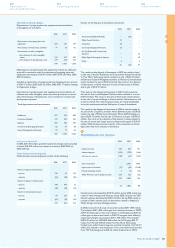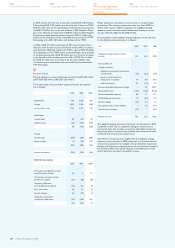Philips 2008 Annual Report Download - page 214
Download and view the complete annual report
Please find page 214 of the 2008 Philips annual report below. You can navigate through the pages in the report by either clicking on the pages listed below, or by using the keyword search tool below to find specific information within the annual report.
IFRIC Interpretation 11 ‘Group and Treasury Share Transactions
IFRIC 11 requires a share-based payment arrangement in which an
entity receives goods or services as consideration for its own equity
instruments to be accounted for as an equity-settled share-based
payment transaction, regardless of how the equity instruments are
obtained. IFRIC 11 was applied by the Company in its 2008 financial
statements. The application of IFRIC 11 did not have any impact
on the Company’s consolidated financial statements.
IFRIC Interpretation 12 ‘Service Concession Arrangements’
IFRIC 12 provides guidance on certain recognition and measurement
issues that arise in accounting for public-to-private service concession
arrangements. IFRIC 12 was applied by the Company on January 1,
2008. IFRIC 12 did not have a material impact on the Company’s
consolidated financial statements.
IFRIC Interpretation 14 ‘The Limit on a Defined Benefit Asset, Minimum
Funding Requirements and their Interaction’
IFRIC 14 addresses (1) when refunds or reductions in future
contributions should be regarded as ‘available’ in the context
of paragraph 58 of IAS 19 Employee Benefits; (2) how a minimum
funding requirement might affect the availability of reductions in
future contributions; and (3) when a minimum funding requirement
might give rise to a liability. This interpretation was applied by the
Company on January 1, 2008. The effect of the application of this
Interpretation is disclosed in Note 56 to the IFRS financial statements.
IFRS accounting standards effective as from 2009 and onwards
A number of amendments and revisions to standards and interpretations
are not yet effective for the year ended December 31, 2008, and have
not been applied in preparing these consolidated financial statements:
Amendments to IAS 1 ‘Presentation of Financial Statements’
The amendments to IAS 1 mainly concern the presentation of
changes in equity, in which changes as a result of the transaction with
shareholders should be presented separately and for which a different
format of the overview of the changes in equity can be selected.
Furthermore, an opening balance sheet of the corresponding period
is presented where restatements have occurred. Philips has chosen
to present all non-owner changes in equity in two statements
(a separate income statement and a statement of comprehensive
income). This Standard is applicable to the Company on January 1, 2009.
Amendments to IAS 32 ‘Financial instruments: Presentation’ and IAS 1
‘Presentation of Financial Statements - Puttable Financial Instruments
and Obligations Arising on Liquidation’
The amendments to IAS 32 and IAS 1 are relevant to entities
that have issued financial instruments that are (i) puttable financial
instruments or (ii) instruments, or components of instruments, that
impose on the entity an obligation to deliver to another party a
pro-rata share of the net assets of the entity on liquidation. Under
the revised IAS 32, subject to specified criteria being met, these
instruments will be classified equity. These amendments are applicable
to the Company on January 1, 2009. The Company expects that
application of this amendment will not have a material impact on
the Company’s consolidated financial statements.
Amendment to IAS 39 ‘Financial Instruments: Recognition and
Measurement – Eligible Hedged Items’
The amendment to IAS 39 provides additional guidance on the
designation of a hedged item. The amendment clarifies how the
existing principles underlying hedge accounting should be applied
in two particular situations. It clarifies the designation of a one-sided
risk in a hedged item and inflation in a financial hedged item. This
amendment is applicable to the Company on January 1, 2010. The
application of this amendment will not have a material impact on
the Company’s consolidated financial statements.
Amendments to IFRS 1 and IAS 27 ‘Cost of an investment
on first-time adoption’
The amendments to IFRS 1 and IAS 27, which will be applicable to
the Company on January 1, 2009, allows first-time adopters to use a
deemed cost of either fair value or the carrying amount under previous
accounting practice to measure the initial cost of investments in
subsidiaries, jointly controlled entities and associates in the separate
financial statements. The amendment also removed the definition
of the cost method from IAS 27 and replaced with a requirement to
present dividends as income in the separate financial statements of
the investor. This standard does not have any impact on the Company’s
consolidated financial statements.
Revision to IFRS 1 ‘First-time Adoption of IFRSs’
The revision to IFRS 1 improves the structure of the Standard
but does contain any technical changes. The revisions are designed
to make the Standard clearer and easier to follow and to better
accommodate future changes to the Standard. This revision is
applicable to the Company on January 1, 2010 but will not have
an impact on the Company’s consolidated financial statements.
Amendments to IFRS 2 ‘Share-based Payment - Vesting Conditions
and Cancellations’
The amendments to IFRS 2, which will be applicable to the Company
on January 1, 2009, clarify the definition of vesting conditions and
the accounting treatment of cancellations by the counterparty to
a shared-based arrangement. The Company expects that this
amendment will not have a material impact on the Company’s
consolidated financial statements.
Revision to IFRS 3 ‘Business Combinations’
The revised standard incorporates the following changes that
are likely to be relevant to the Company’s operations:
The definition of a business has been broadened, which is likely to
•
result in more acquisitions being treated as business combinations.
Contingent consideration will be measured at fair value, with the
•
subsequent changes therein recognized in statement of income.
Transaction costs, other than share and debt issue costs, will be
•
expensed as incurred.
Any pre-existing interest in the acquiree will be measured at fair
•
value with gain or loss recognized in the income statement.
Any non-controlling (minority) interest will be measured at either
•
fair value, or at its proportionate interest in the identifiable assets
and liabilities of the acquiree, on a transaction-by-transaction basis.
The revision to IFRS 3 is mandatory for the Company’s business
combinations beginning January 1, 2010 and will have no impact
on prior periods.
Amendments to IAS 27 ‘Consolidated and Separate Financial Statements’
The amendments to IAS 27 require accounting for changes in ownership
interest by the Company in a subsidiary, while maintaining control, to
be recognized as an equity transaction. When the Company loses
control of a subsidiary, any interest retained in the former subsidiary
will be measured at fair value with the gain or loss recognized in the
statement of income. The amendments to IAS 27 will be applicable
to the Company on January 1, 2010. These are not expected to have
significant impact on the consolidated financial statements.
Improvements to IFRS 2008
The improvements published under the IASB’s annual improvement
process are intended to deal with non-urgent, minor amendments
to the standards. Most of the improvements are applicable to the
Company on January 1, 2010, some on January 1, 2009.
The improvements to IFRS 2008 relate mainly to the following:
Disclosure requirements: Classification as held for sale of the
•
assets and liabilities of a subsidiary where the parent is commited
to a plan to sell its controlling interest but intends to retain a
non-controlling interest.
Reclass to inventories of PP&E previously held for rental when the
•
assets cease to be rented and are held for sale, and the recognition
of the proceeds of disposal of such assets as revenue.
Recognition of a government grant arising from government
•
loans at below-market interest.
Recognition of advertising and promotional expenditure as an
•
asset is not permitted beyond the point at which the entity has
the right to access the goods purchased or services received.
Classification of property under construction for investment •
purposes as investment property under IAS 40.
The Company has not yet determined the potential impact of those
improvements.
IFRIC Interpretation 13 ‘Customer Loyalty Programmes’
IFRIC 13 addresses recognition and measurement of the obligation to
provide free or discounted goods or services in the future. This
interpretation will be applicable to the Company on January 1, 2009.
The application of this interpretation will not have a material impact
on the Company’s consolidated financial statements.
Philips Annual Report 2008214
180
Sustainability performance
244
Company financial statements
124
US GAAP financial statements
192
IFRS financial statements
Significant IFRS accounting policies


